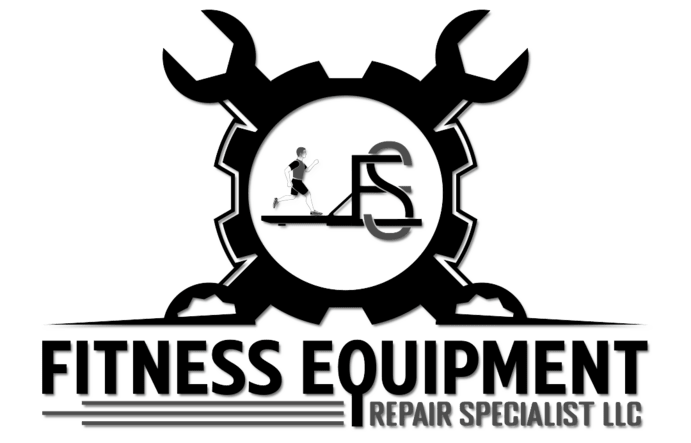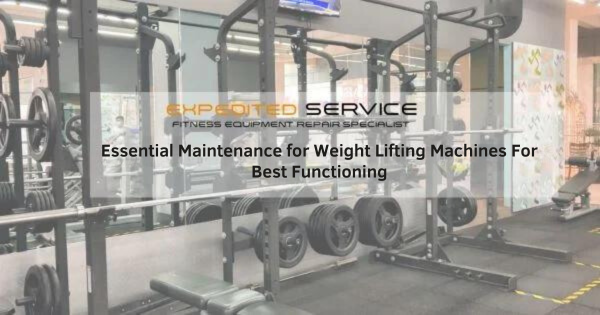
Elliptical El Dorado – How To Maintain Your Elliptical for Highest Performance
April 28, 2024
Preventing and Fixing Common Issues with Fitness Benches
May 2, 2024Investing time in maintaining your weight lifting machines goes far beyond keeping them shiny. Regular upkeep plays a important role in ensuring a safe and effective workout environment. Just like a car needs regular servicing, weight machines require maintenance to function smoothly and safely.
By addressing wear and tear, you minimize the risk of injuries caused by malfunctioning equipment. Furthermore, proper maintenance extends the lifespan of your machines, saving you money on costly replacements down the line. Let’s learn about the maintenance steps of a weight lifting companion to keep it safe to maximize your workout results!
Weight Lifting Machines Maintenance Checklist:
Safety First! Before performing any maintenance, ensure the machine is unplugged or powered down, and no weights are loaded.
1 – Daily Maintenance (Before and After Each Use):
To maintain a clean and hygienic workout environment, regularly cleaning and disinfecting surfaces on your elliptical machine is essential. With just a few simple supplies such as disinfecting wipes and a damp cloth, you can effectively remove dirt, sweat, and bacteria buildup in as little as 10 minutes. Begin by wiping down all surfaces of the elliptical, focusing on areas frequently touched like the handles, console, and pedals. Use disinfecting wipes to kill germs and sanitize surfaces, followed by a damp cloth to remove any residue. This quick and easy cleaning routine helps ensure a safe and hygienic workout experience for you and other users. Here are some key instructions for it:
- Wipe down all surfaces, including handles, seats, pads, and weight horns, with disinfecting wipes or a damp cloth with a mild cleaning solution (water with a few drops of dish soap).
- Pay particular attention to areas with high sweat contact.
- Allow surfaces to air dry completely before next use.
2 – Weekly Maintenance (30 minutes):
Lubricating the moving parts of your weight lifting machine is a quick and essential maintenance task that can significantly improve its performance and longevity. In just 10 minutes, you can ensure smooth operation and reduce wear and tear on the machine.
To begin, gather your user manual, a suitable lubricant designed for gym equipment or specifically for your weight lifting machine, and a clean rag. Following the instructions in your manual, apply the lubricant to the designated moving parts, focusing on areas such as pulleys, guide rods, and pivot points. Wipe away any excess lubricant with the clean rag to prevent buildup. This simple yet effective maintenance routine can keep your weight lifting machine running smoothly for years to come. Here are the key instructions for this:
- Consult your user manual for designated lubrication points (typically rails, guide rods, and other moving parts).
- Apply a thin layer of lubricant directly onto the designated points using a clean rag.
- Wipe away any excess lubricant to prevent a slippery surface.
3 – Checking Cables and Pulleys for Wear and Tear (10 minutes):
Regularly checking cables and pulleys for wear and tear is crucial for ensuring the safety and effectiveness of your weight lifting machine. In just a few minutes, inspect cables for fraying or signs of weakness, and examine pulleys for any damage or misalignment.
Addressing these issues promptly can prevent accidents and equipment malfunction, maintaining the integrity of your workouts and extending the lifespan of your machine. Here are instructions to follow:
- Visually inspect all cables for fraying, kinking, or rust.
- Use a flashlight (if needed) to examine hard-to-reach areas.
- Check pulleys for any cracks or signs of uneven movement.
- If you notice any damage, stop using the machine and replace the cables or consult a qualified technician.
4 – Inspecting Weight Stacks and Securing Bolts (10 minutes):
Inspecting weight stacks and securing bolts on your weight lifting machine is a vital maintenance task that only takes 10 minutes and ensures safety and functionality. Begin by consulting your user manual to locate the bolts that need checking. With the appropriate wrenches or screwdrivers on hand, tighten any loose bolts to prevent accidents during workouts.
Simultaneously, examine weight stacks for signs of damage or imbalance, addressing any issues promptly. This routine maintenance not only enhances the safety of your workouts but also preserves the integrity of your machine, ensuring optimal performance for future sessions. Your instructions for this are as mention here:
- Ensure the weight stack moves freely and all pin selections function correctly.
- Visually inspect the weight stack for any broken or damaged plates.
- Check all bolts, nuts, and screws on the weight stack frame and selector mechanism for looseness.
- Use appropriate tools to tighten any loose fasteners according to the user manual’s torque specifications (if available).
5 – Monthly Maintenance Plan For Weight Lifting Machine (45 minutes):
Incorporating monthly maintenance into your routine for a weight lifting machine includes calibrating resistance settings, particularly for selectorized machines.
Using the user manual as a guide, adjust the resistance levels to ensure accuracy and consistency in your workouts. If necessary, utilize weight plates for calibration purposes.
This simple yet essential task ensures that your machine provides the intended resistance levels for effective strength training sessions, maintaining the quality and reliability of your workouts over time
Note: Calibration can be a complex process. If unsure about any steps, consult a qualified technician.
6 – Upholstery Cleaning (if applicable) (15 minutes):
To keep your weight lifting machine in pristine condition, you’ll need a mild cleaning solution comprising water mixed with a few drops of dish soap, along with a damp cloth. This gentle yet effective solution helps remove dirt, sweat, and grime from the surfaces of your machine without causing damage.
That is why, regular cleaning not only maintains the aesthetic appeal of your equipment but also promotes hygiene, ensuring a clean and comfortable workout environment for every session. You may go with these instructions:
- For machines with padded seats or backrests, use a damp cloth with a mild cleaning solution to remove dirt and sweat build-up.
- Avoid using harsh chemicals or abrasive cleaners.
- Allow the upholstery to dry completely before next use.
You can make sure your weight lifting machines stay secure, dependable, and prepared to assist you in reaching your fitness objectives for many years to come by according to this checklist and scheduling routine maintenance into your schedule.
Understanding that Each Type of Weight Lifting Machine is Different :
Gyms offer a variety of weight lifting machines to cater to different training styles and muscle groups. Here’s a breakdown of some common types:
- Free weights like dumbbells and barbells offer the most flexibility, allowing for personalized exercise routines. Maintenance for these is simple, requiring checks for damaged plates, worn grips, and proper storage to prevent rust or warping.
- Cable machines utilize scables and weighttacks to provide resistance in various directions. They offer a guided workout but with more freedom than selectorized machines. Regular maintenance involves lubricating moving parts, inspecting cables for fraying, and ensuring smooth operation of pulleys.
- Plate-loaded machines feature weight plates that users load and unload to adjust resistance. These machines target specific muscle groups and offer a controlled movement pattern. Maintenance involves checking the weight selection mechanism for smooth operation, ensuring secure bolts on the frame, and lubricating guide rods.
- Selectorized machines are user-friendly, offering pre-set weight stacks and levers for targeted exercises. These require minimal setup but have limited variation. Regular upkeep includes lubricating moving parts, ensuring weight stacks function smoothly, and calibrating resistance settings (on some models).
A safe and efficient training environment for all users is ensured by having a thorough understanding of the various machine types and their maintenance needs. You’ll be well on your way to maintaining the iron-strong and your members happy if you stick to these routines in your gym.
When faced with stubborn problems beyond your expertise, seeking professional help is most important to identify and resolve the root cause effectively.
NJ Fitness Equipment Repair offers comprehensive services across New Jersey and New York, including Rockland County, parts of Orange County, Westchester County, the Bronx, and NYC!
We offer repair, servicing, and maintenance for gym equipment, guaranteeing smooth functioning and user happiness. We specialize in maintaining weight lifting machines for maximum performance. Our staff is committed to providing excellent service to satisfy your needs, whether it be for home or commercial gym equipment repair, servicing, or upkeep. You can rely on NJ Fitness Equipment Repair to maintain your weightlifting machines in top working order for outstanding results.
Learning The Specific Maintenance Requirments for Each Type:
Learning specific maintenance tips tailored to each type of weight lifting machine is essential for ensuring optimal performance and longevity. For free weights, proper storage and regular checks for rust or damage are crucial to maintain their integrity and safety. Cable machines require inspection of cables for fraying and adjustments to tension to ensure smooth operation. Plate-loaded machines need regular checks of weight plates for damage or imbalance, preventing accidents during workouts. Selectorized machines benefit from calibration of weight stacks and regular inspection of upholstery for tears, ensuring accurate resistance and user comfort.
In troubleshooting common issues, identifying problems like sticking cables or loose bolts is key. Prompt action, such as lubricating cables or tightening bolts, can resolve these issues efficiently, minimizing downtime and ensuring uninterrupted workouts. Additionally, considering professional maintenance services offers benefits like expert knowledge and specialized tools, ensuring thorough and efficient maintenance that prolongs equipment lifespan and enhances user safety and satisfaction.
Conclusion:
Regular maintenance of gym equipment provides numerous benefits that are critical to both gym operations and user happiness. Facilities can prioritize safety by performing timely inspections and maintenance to prevent accidents and encourage a safe workout environment. Plus, planned maintenance saves downtime by treating issues before they develop, ensuring members’ continuous access to equipment. Moreover, regular maintenance protects the investment in equipment, extending its life and maximizing performance. While, these maintenance methods improve gym operations, raise user satisfaction, and provide a positive experience for members, maintaining the facility’s reputation as a dependable and safe fitness destination.

